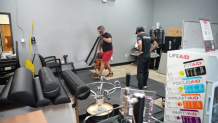Chris Garcia is tired. Tired of cleaning up after flooding. And tired of the negative impact it’s had on his business, Sports Performance Physical Therapy on Pacific Highway in the Midway District.
“We’re doing a full deep clean with products to help kill any bacteria that were here,” Garcia said. “It's a safety hazard if we don’t do this the right way.”
There’s also a lot of damage that mops, buckets, and dehumidifiers can’t fix.
“As a business owner you take that home,” Garcia told us. “Most people, who don’t know how much you take home. And it’s a lot.”
Get San Diego local news, weather forecasts, sports and lifestyle stories to your inbox. Sign up for NBC San Diego newsletters.
The flooding he and neighboring businesses along Pacific Highway experienced on Monday is what can happen when the city pump station down the street stops working.

“This is the second time,” Garcia said. “The reason why this is so hard, is because this is the second time it’s happened. The exact same scenario happened February 25th of 2023! We’ve been here before. Less than a year ago. With less rain.”
The city says its pump station on Pacific Highway in Midway was one of two stations that lost power during the rain. A pump station is like an underground water tank, but for rain runoff. When it gets full enough, pumps are supposed to push that water out into a bay or ocean.

So far, the response from city leaders is that they were prepared for Monday’s rain storm, but could not have possibly predicted an unprecedented act of nature. City officials have called it a thousand-year storm.
“None of us alive have seen anything quite like this,” Mayor Gloria said in news conference outside Lincoln High School on Tuesday.
NBC 7 Chief Meteorologist Sheena Parveen says the hardest hit areas in our county saw at most 2 inches of rain per hour over three hours.
“It wasn’t feet of rain,” Parveen said. “We didn’t see feet of rain.”
She says even the areas worst hit would have only seen 6 inches of rain total.
“Something else is going on,” Parveen said. “Because that’s not coming from just 4 inches to 6 inches of rain.”
The city says a lot of factors played a role in the flooding in addition to the intense rainfall. A spokesperson says the flooding around Chollas Creek is downstream from most of the county, so that area accepted all the floodwater from La Mesa and Lemon Grove. They also pointed out that many of the neighborhoods were built in flood plains, close to flood channels, saying developers would never be allowed to develop those areas today.
City officials don’t deny the stormwater infrastructure is aging, but over the last week, leaders have been adamant there wasn't much any city could have done to prevent the outcome.
“The amount of water that we saw yesterday would have overwhelmed any city’s drainage system,” Mayor Gloria said multiple times during that Tuesday press conference.
However, four months ago, city leaders predicted this level of devastation; in on-camera interviews with NBC 7 Investigates. At the time, city engineers took us inside our deteriorating stormwater system.
That included a tour of the Mission Beach pump station along Mission Boulevard and Pacific Beach Drive. Most of the city’s 15 pump stations were built 50-100 years ago. Officials say they were never designed for the San Diego of today, and it shows.
“Water is leaking out through the walls,” Civil Engineer Michael Phillips told us. “Like I said, there’s cracks everywhere, water is coming through.”
Months before that pump station tour, last spring, Mayor Todd Gloria told us, above all, it’s the stormwater system that keeps him awake at night.
“The areas where I’m very concerned are specifically our stormwater system, which is usually out of sight, out of mind, until there’s a lot of rain, and the people want to ask why aren’t we doing more on that,” Gloria said.
In a presentation before a city council committee last year, stormwater officials said four pump stations were at risk of critical failure, meaning blocks of streets would be submerged in feet of flooding.
Todd Snyder is the Director of San Diego’s Stormwater Department.
“Everytime it rains, we are really, really vulnerable,” Snyder said in an interview with NBC 7 Investigates back in September.
It’s not just the pump stations that need an overhaul. Thousands of miles of underground pipes are 50 to 75 years past their lifespan. Snyder told us 20 sinkholes in 2022 alone were a direct result of outdated city stormwater pipes that burst underground.
“There’s a significant cost of doing nothing,” Snyder said. “If we don’t start investing more into our stormwater system, the level of damage we’re going to see after every rain season is going to get more and more significant.”
That prediction reared its ugly head on Monday. The city says 6 of its 15 stormwater pump stations were overwhelmed during the storm. Two were still out of service two days later.
No single mayor or city administration is responsible for the state of our stormwater system today. That happened over decades. A fix is projected to be a costly one, with money the city says it doesn’t have. Snyder says the stormwater department falls short about $300 million dollars each year. The total deficit stands at well over one billion dollars. San Diego got a multi-million dollar grant for some design plans for a few new pump stations, but it’s nowhere close to catching up to that deficit.
It’s frustrating for Garcia, who believes this was preventable.
“Where is the money going?” Garcia said. “And what are we going to do about this long term? Because what that does to the San Diego economy is people don’t want to be around here! They don’t want to drive down this street. They don’t want to be a patron at a business that puts them at risk!”
In the meantime, Garcia says there’s something every San Diegan can do now – visit and support local businesses that flooded on Monday. If you crave some coffee, or a haircut, or massage, consider getting one at a recovering business first.

